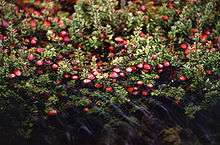Vaccinium macrocarpon
| Vaccinium macrocarpon | |
|---|---|
 | |
| Scientific classification | |
| Kingdom: | Plantae |
| (unranked): | Angiosperms |
| (unranked): | Eudicots |
| (unranked): | Asterids |
| Order: | Ericales |
| Family: | Ericaceae |
| Genus: | Vaccinium |
| Subgenus: | Oxycoccos |
| Species: | V. macrocarpon |
| Binomial name | |
| Vaccinium macrocarpon Aiton 1789 | |
| Synonyms[1][2] | |
|
Synonymy
| |
Vaccinium macrocarpon (also called large cranberry, American cranberry and bearberry) is a North American species of cranberry of the subgenus Oxycoccus and genus Vaccinium.
Vaccinium macrocarpon is native to central and eastern Canada (Ontario to Newfoundland) and the northeastern and north-central United States (Northeast, Great Lakes Region, and Appalachians as far south as North Carolina and Tennessee).[3] It is also naturalized in parts of Europe and scattered locations in North America along western Canada (British Columbia) and the western United States (West Coast).
Vaccinium macrocarpon is a shrub, often ascending (trailing along the surface of the ground for some distance but then curving upwards). It produces white or pink flowers followed by sour-tasting red or pink berries 9–14 mm (0.35–0.55 in) across.[4][5]
The species is grown commercially as a cash crop for its edible berries.[6] Many of these are grown in artificial ponds called cranberry bogs.[7] There is some evidence suggesting that the berries or their juice is useful in treating certain urinary tract infections.[8][9]
See also
References
- ↑ Tropicos, Vaccinium macrocarpon Aiton
- ↑ The Plant List, Vaccinium macrocarpon Aiton
- ↑ "Biota of North America Program 2014 county distribution map". BONAP.net. Retrieved 13 June 2017.
- ↑ Flora of North America, Vaccinium macrocarpon Aiton, 1789. Cranberry, canneberge gros fruits
- ↑ Aiton, William. 1789. Hortus Kewensis, or, A catalogue of the plants cultivated in the Royal Botanic Garden at Kew 2: 13 and plate 7 description in Latin on page 13; full-page color illustration on plate 7 (between pages 12 and 13)
- ↑ "Vaccinium macrocarpon American Cranberry, Cranberry PFAF Plant Database". www.PFAF.org. Retrieved 13 June 2017.
- ↑ University of Massachusetts, Natural History of the American Cranberry, Vaccinium macrocarpon Ait.
- ↑ Mayo Clinic, Cranberry (Vaccinium macrocarpon)
- ↑ Pérez-López, FR; Haya, J; Chedraui, P. "Vaccinium macrocarpon: an interesting option for women with recurrent urinary tract infections and other health benefits". J Obstet Gynaecol Res. 35: 630–9. doi:10.1111/j.1447-0756.2009.01026.x. PMID 19751320.
External links
- Lady Bird Johnson Wildflower Center, University of Texas
- Zalapa, J.E.; Bougie, T.C.; Bougie, T.A.; Schlautman, B.J.; Wiesman, E.; Guzman, A.; Fajardo, D.A.; Steffan, S.; Smith, T. (6 November 2014). "Clonal diversity and genetic differentiation revealed by SSR markers in wild Vaccinium macrocarpon and Vaccinium oxycoccos". Annals of Applied Biology. 166 (2): 196–207. doi:10.1111/aab.12173.
| Wikispecies has information related to Vaccinium macrocarpon |
| Wikimedia Commons has media related to Vaccinium macrocarpon. |